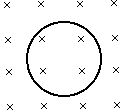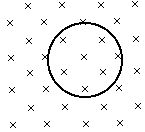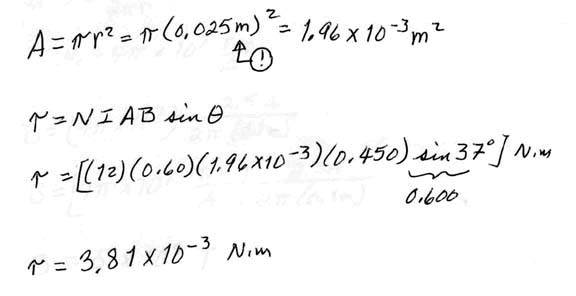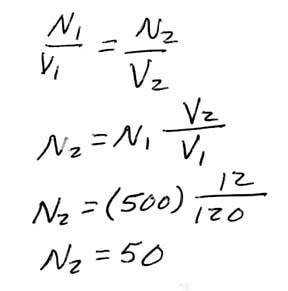

PHY1161
Exam #2
October 7, 2002
High: 80
Mean: 41
Low : 5
1. What is the resonance frequency of a series RCL circuit with a 15resistor, a 250 µF capacitor, and a 200 mH inductor?
What current will flow in the circuit if it is connected to a 20 V supply at this resonance frequency?
What current will flow if the frequency is increased by 30%?


2. A 25–turn, circular coil of wire, with an area of 225 cm2 is placed in a 0.075 T magnetic field. The magnetic field is perpendicular to the coil and points into the page as shown in the figure above. The magnetic field strength increases uniformly so that in 5.0 seconds it has a value of 0.125 T.
What is the area of the coil in units of m2?
What voltage -- or emf -- is induced in this coil?
In which direction does the induced current flow?We all know that 100 cm = 1 m
The "trouble" starts when we need to convert areas instead of merely distances!
A = 225 cm2
A = 225 cm2 [ 1 m/100 cm]2
Be sure the whole expression is squared!
A = (225/10 000) m2
A = 225 x 10 - 4 m2
A = 0.0225 m2
3. A twelve–turn current coil carries 0.60 A of current in a region where the magnetic field is 0.450 T. The coil is a circle of radius 2.5 cm. Find the torque exerted on the coil when it is rotated so the normal to the coil makes an angle of 37° with the magnetic field.
(Hint: Be careful of the units -- find the area of the coil in m2).
The “normal to the coil” is the direction perpendicular to the coil.

4. What is the magnetic field strength B at a distance of 0.1 m from a very long, straight wire that carries a current of 2.5 A?
Concept Questions —
i) What is Lenz’s Law or what does Lenz’s Law mean?

ii) Consider a transformer that will be used to change regular 120-volt AC electricity into 12-volt AC electricity to power some electronic device. The “primary” winding, connected to the 120-volt source has 500 turns. How many turns should there be in the “secondary” winding which will provide the 12-volt output electricity?

iii) Consider an R-C-L series circuit. Can the total impedance ever
be less than the resistance R?

iv) Consider an R-C-L series circuit. Can the total impedance ever
be more than the resistance R?
